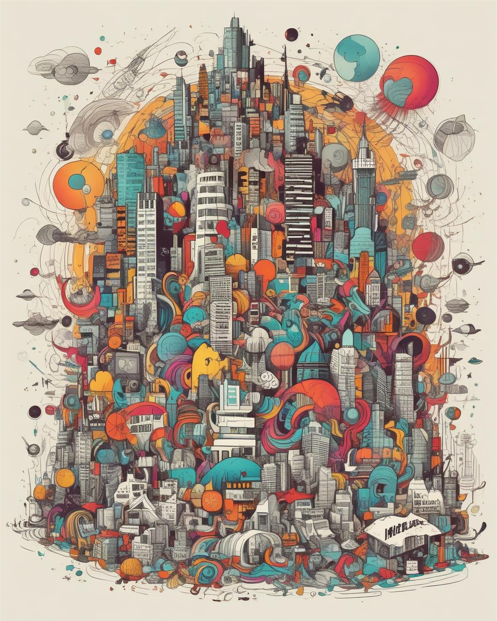By Tyron Devotta
In the mid-20th century, Canadian media theorist Marshall McLuhan transformed the way we thought about communication. With now-famous phrases like “The medium is the message” and “the global village,” McLuhan foresaw how electronic media—especially television—would reshape human consciousness. He argued that media would create a collective sensory environment, effectively rewiring society into a mass mind, where people shared not only content but perceptions.
“The new electronic interdependence recreates the world in the image of a global village.” – Marshall McLuhan
McLuhan believed that media had the power to re-tribalize humanity, dissolving individual identities into a shared nervous system. The 20th century saw the rise of global broadcasts, collective news consumption, and media-driven consensus.
But then came Alvin Toffler.
In Future Shock (1970) and The Third Wave (1980), Toffler advanced McLuhan’s ideas into a radically individualized future. Instead of a global village, Toffler imagined a world of “blip culture”—where media would no longer be broadcast to masses, but instead tailored to the individual. The “mass mind” would dissolve into millions of micro-minds, each consuming its own curated feed of information. With prophetic clarity, Toffler foresaw the rise of digital personalization, email, news alerts, and the internet-driven information stream that we now take for granted.
“The old mass media were impersonal, uniform, centralized, and one-way. The new media are personal, diverse, decentralized, and interactive.”
— Alvin Toffler, The Third Wave
The Promise: AI and the Blip Revolution Fulfilled
Today, AI has fulfilled Toffler’s prophecy. Algorithms now deliver news and information that is customized, instantaneous, and behaviorally optimized. Our phones know what we want before we do. News is pushed to us based on our likes, shares, clicks, and even emotional tone.
We live in a world of hyper-personalization.
But with this fulfillment came a price neither McLuhan nor Toffler fully anticipated: the collapse of a shared reality.
The Problem: Truth Has Shattered
In the AI-driven media landscape, truth itself has become fragmented. The same technologies that personalize content also enable the seamless spread of fake news, deep fakes, AI-generated misinformation, and manipulated narratives. The once-reliable institutions of verification—press, academia, legal systems—are no longer trusted by large swaths of the population.
We are no longer experiencing a breakdown of media.
We are witnessing a breakdown of our belief system.
Welcome to the New Tower of Babel
This isn’t just an information crisis. It’s an epistemological crisis—a crisis of how we know what we know.
Epistemological refers to anything related to the origin, nature, limits, or validity of knowledge.
Questions like:
- What counts as a fact?
- How can we be sure something is true?
- Can knowledge be objective or is it always shaped by perspective?
Like the biblical Tower of Babel, where humanity’s common language was splintered into confusion, we are now speaking in tongues of data, memes, conspiracy, and algorithmic hallucinations.
- People increasingly believe what feels true, rather than what can be proven.
- Media consumers inhabit echo chambers, where dissent is algorithmically filtered out.
- Shared facts have been replaced by tribal truths, driven by identity rather than evidence.
McLuhan’s “mass mind” has fractured into millions of isolated realities, and Toffler’s blip culture has become a torrent of noise, where credibility is optional and confusion is constant.
Are We Still Consuming News — Or Escaping It?
This raises an urgent question: Will people stop consuming news altogether? In many ways, they already are. The exhaustion of navigating misinformation, the anxiety of not knowing what’s real, and the sheer volume of noise are pushing people to disengage. For some, the healthiest mental choice is to disconnect—to turn off the blips and stop chasing truth altogether.
But this withdrawal carries a steep cost. If society loses its shared factual foundation, we risk losing democracy, cohesion, and civilizational continuity. Without agreement on basic realities, debate becomes impossible, governance collapses, and common purpose disappears.
What Lies Beyond This Point?
While the situation appears bleak, the answer may lie not in rejecting technology, but in rebuilding trust and designing systems of verification that work in a personalized world.
- Media literacy must become as essential as reading and writing.
- AI tools should be developed to verify as well as generate.
- Institutions of credibility—science, journalism, academia—must be reimagined for the digital age, with transparency and accountability at their core.
- And most importantly, we must reclaim the human responsibility to question, reflect, and seek truth beyond convenience.
We may be in an age of confusion. But confusion, as history shows, can also be the precursor to clarity. The Tower of Babel story didn’t end with destruction—it led to diversity, creativity, and eventual understanding.
Perhaps our challenge today is not to return to one truth, but to build a new grammar for understanding many truths, rooted in empathy, reason, and shared humanity.



